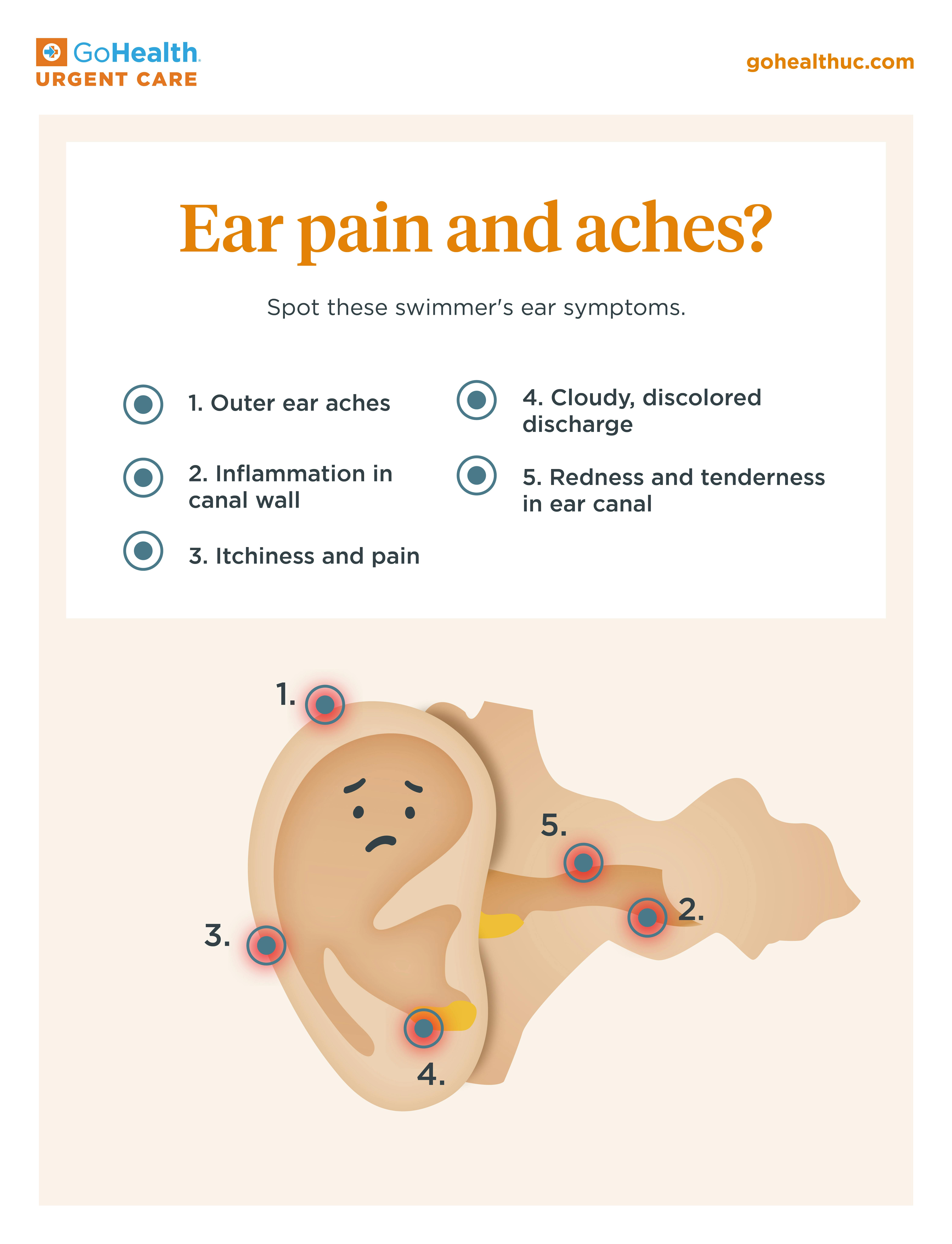What to do if your child gets swimmer’s ear
Medically reviewed by Dr. Betsy Koickel, MD on June 17th, 2025.
If you’re a parent, you’ve likely experienced the common childhood middle ear infection. This type of ear infection is caused by inflammation of the eardrum and is often associated with an upper respiratory infection.
Less typical is swimmer’s ear (or otitis externa), which affects the skin lining of the outer ear canal, just outside the eardrum. What might surprise you, though, is that, despite fewer reported cases of swimmers’ ear, it still accounts for over 2.4 million healthcare visits in the U.S. annually.
Ear infections like swimmer’s ear are one of the most common conditions we see at urgent care.

Is it swimmer’s ear? Recognizing the signs in kids
If your child has otitis externa, you’ll probably know pretty quickly. Unlike a middle ear infection, one of the key indicators of a swimmer’s ear is pain when chewing, pulling on the earlobe, or pressing on the “tag” on the front of the ear. It’s most common in children and adolescents aged 5 to 18. A high percentage of instances occur during the summer months when kids spend a lot of time in the pool – hence the name swimmer’s ear!
Moisture from water in a child’s ear can be a culprit. However, it’s not the only reason for otitis externa. Any disturbance to the ear canal's wax-skin barrier can increase the risk of infection.
Under normal conditions, earwax (or cerumen) provides a barrier to the ear canal’s skin lining because it seals out moisture and traps debris with its stickiness. But excessive water exposure can cause the skin to soften and become macerated, creating a favorable environment for the growth of bacteria or fungi.
Abrasions to the outer ear can also lead to bacterial or fungal infections. If your child uses cotton-tip swabs, earplugs, or headphones, or accidentally scratches their ear, it can result in a break in the skin lining, allowing bacteria to enter the area.
Certain hair care products and jewelry can also be irritants. Plus, those who suffer from skin conditions like eczema and seborrhea are at higher risk for infection.
Besides an outer earache, other symptoms to be aware of with swimmer’s ear are redness and swelling of the ear canal, as well as tender or enlarged lymph nodes in this area.
Sometimes, a cloudy, yellowish discharge can fill up the outer ear. Should swelling or pus block the auditory canal, your child might also temporarily lose hearing.
What home remedies provide pain relief from swimmer’s ear?
Most of the time, swimmer’s ear is not an emergency. But that doesn’t mean it’s not painful. Even mild otitis externa can cause discomfort.
Certain swimmer’s ear treatments can be used to alleviate pain. A heating pad can be applied to your child’s infected ear to dry it out. To avoid accidental burning, it’s best to keep the heating pad on its lowest setting and use it for short durations only.
If these remedies don’t provide the desired relief, you can also try an over-the-counter medication such as acetaminophen or ibuprofen.
No matter how itchy or irritating the infection becomes, encourage your child to keep their fingers away from the ear. Removing any visible discharge or debris can lead to further trauma.
Plus, while your child might want to get right back into the water, they should avoid swimming until the symptoms subside, as continued swimming can slow their recovery.
When should we visit urgent care?
A swimmer’s ear infection that results in prolonged pain, discharge, or swelling may require a visit to the doctor.
A provider can easily diagnose otitis externa by taking a brief history and conducting a simple physical exam, which includes examining your child’s ear to determine whether the infection is internal or external to the eardrum.
Depending on what is found, the doctor may recommend a prescription for an antibiotic ear drop. Insertion of an ear wick may be needed for more severe cases of otitis externa, where the canal shows significant swelling, to allow adequate penetration of antibiotic drops. If your child suffers from recurring infections, their doctor may also refer you to an otolaryngologist (ear, nose, and throat specialist) for further examination.
How to prevent swimmer's ear in your child
Knowing how painful a swimmer’s ear can be, parents often ask how they can prevent an earache caused by water in the first place.
Precautions you can take to ensure they’re safe this summer:
- Keep your child’s ears as water-free as possible when swimming. Custom-fitted swim caps and earplugs can help to protect the ear canal. However, excessive use should be avoided, as this can lead to swimmers' ear.
- Check the pool pH levels and ensure the water is properly disinfected.
- Avoid swimming in lakes or rivers that have high levels of bacteria.
- Dry your child’s ears completely after swimming.
Here are some safe methods for how to remove water from a child’s ear:
- Let gravity do the work. Outside of using a towel to dry your child’s ears, the most practical way to remove water is to tilt their head and hold each ear facing down. Pulling the earlobe in different directions while the ear is face down can help drain water.
- Create suction with your hands. Have your child cup their palm tightly over the ear and tilt their head to the side, mimicking a vacuum. This can help loosen up the water so it can be pulled out.
- Apply a warm compress. Try using a warm washcloth as a compress over your child’s ear to extract water and help soothe discomfort.
- Use a hair dryer. To help evaporate any trapped water, place a hair dryer on its lowest setting and hold it about a foot from your child’s ear. Move it back and forth slowly to distribute the air's force. You can also simultaneously tug on the earlobe to help release water.
- Make an ear drop mixture. Similar to vinegar and hydrogen peroxide ear drops, a mixture of half water and half alcohol can also be used to help soften earwax and drain any trapped water.
In addition, your child should avoid using cotton-tip swabs to remove water or earwax from their ear. Swabs and other items, such as bobby pins or fingernails, can cause a break in the skin's lining. They can also push wax further back into the ear canal, where it doesn’t belong, and this may require medical assistance to remove it.
Accidentally pushing swabs too far can also damage the eardrum or the tiny hearing bones (hammer, anvil and stirrup) underneath.
Complications with chronic swimmer’s ear
With proper treatment, instances of acute (not chronic) otitis externa usually clear up in 7-10 days. However, if the outer ear infection isn’t easily resolved or reoccurs in multiple sequential episodes, it can lead to chronic otitis externa.
An acute case of swimmer’s ear can become chronic if the bacteria or fungus that’s causing the infection is a rare strain, the infection is both bacterial and fungal, or your child has an allergic reaction to an antibiotic prescribed.
Symptoms of chronic swimmer’s ear include a fever and pain that radiates to the face, neck and head. If untreated, it can lead to conditions such as hearing loss or cellulitis.
Treatment for chronic otitis externa with antibiotic ear drops or oral antibiotics is usually successful. But depending on the severity of the infection, it may take some time and require repeat treatment.
Other ear conditions that may cause ear pain
Eustachian tube dysfunction
Eustachian tube dysfunction usually occurs during or after a deep-water dive. It is a result of the barometric change, so divers are particularly affected. It can also occur from a reaction to the chlorine in a swimming pool, which may cause the lining of the nose to become irritated, thinning the tubes over time. The pressure pushing bacteria and mucus into the ear has also been known to cause this dysfunction.
Nose and earplugs may help prevent this from happening. During a dive, you can also slowly breathe out the air from your mouth until you reach the surface.
Medical treatments for eustachian tube dysfunction include nasal decongestants and antibacterial ear drops.
Malignant external otitis
While rare, malignant external otitis develops when bacteria infect the bones inside the ear canal and spread to the base of the skull. Symptoms include ear pain with sudden facial paralysis, hoarseness, hearing loss and throat pain.
Older adults with diabetes, anyone with HIV, and children who have impaired immune systems are at the highest risk for malignant external otitis. Antibiotics are used to treat this infection.
To summarize
As your family turns to the pool to find relief from hot summer days, it’s important to take extra precautions to avoid the discomfort of swimmers’ ear in kids. Individuals are more susceptible to otitis externa when they spend large amounts of time swimming, especially in water with high levels of bacteria.
Children, in particular, are more vulnerable to infection because their ear canals are narrower. You can help prevent swimmer’s ear by ensuring your child’s ears stay dry. It will be a long summer if they have to sit poolside while all their friends are enjoying the water.
If you or your child is experiencing ear pain or concerns that don't resolve after 2-3 days of conservative management, find the nearest GoHealth Urgent Care Center and walk in or save your spot online. One of our skilled providers would be happy to assess your concerns and get you back on the path to feeling better.
FAQs
Here are some frequently asked questions about swimmers’ ear in kids.
How is swimmer's ear diagnosed in kids?
A healthcare provider will diagnose swimmers’ ear by examining the child’s ear for signs of redness, swelling, or tenderness in the ear canal. They may also gently tug on the ear to evaluate for signs of pain.
How long does swimmer's ear typically last with treatment?
With at-home swimmer’s ear treatment or eardrops, symptoms typically improve in 2-3 days.
Can my child swim while being treated for swimmer's ear?
No, children with swimmer’s ear should not swim for at least 7-10 days to ensure the ear has properly healed.
Is swimmer's ear contagious?
No, swimmer’s ear is not contagious.
Does earwax help prevent swimmer's ear?
Yes, earwax can help lower the risk of swimmer’s ear by preventing moisture from getting trapped inside the ear.
References:
- https://www.cdc.gov/healthy-swimming/prevention/preventing-swimmers-ear.html?CDC_AAref_Val=https://www.cdc.gov/healthywater/swimming/swimmers/rwi/ear-infections.html
- https://hartfordhealthcare.org/health-wellness/health-resources/health-library/detail?id=swear
- https://www.childrens.com/health-wellness/how-to-get-rid-of-swimmers-ear
- https://www.enthealth.org/whats-an-ent/
- https://www.michiganmedicine.org/health-lab/why-you-really-shouldnt-use-q-tip-clean-your-ears
- https://www.aafp.org/pubs/afp/issues/2003/0715/p309.html


